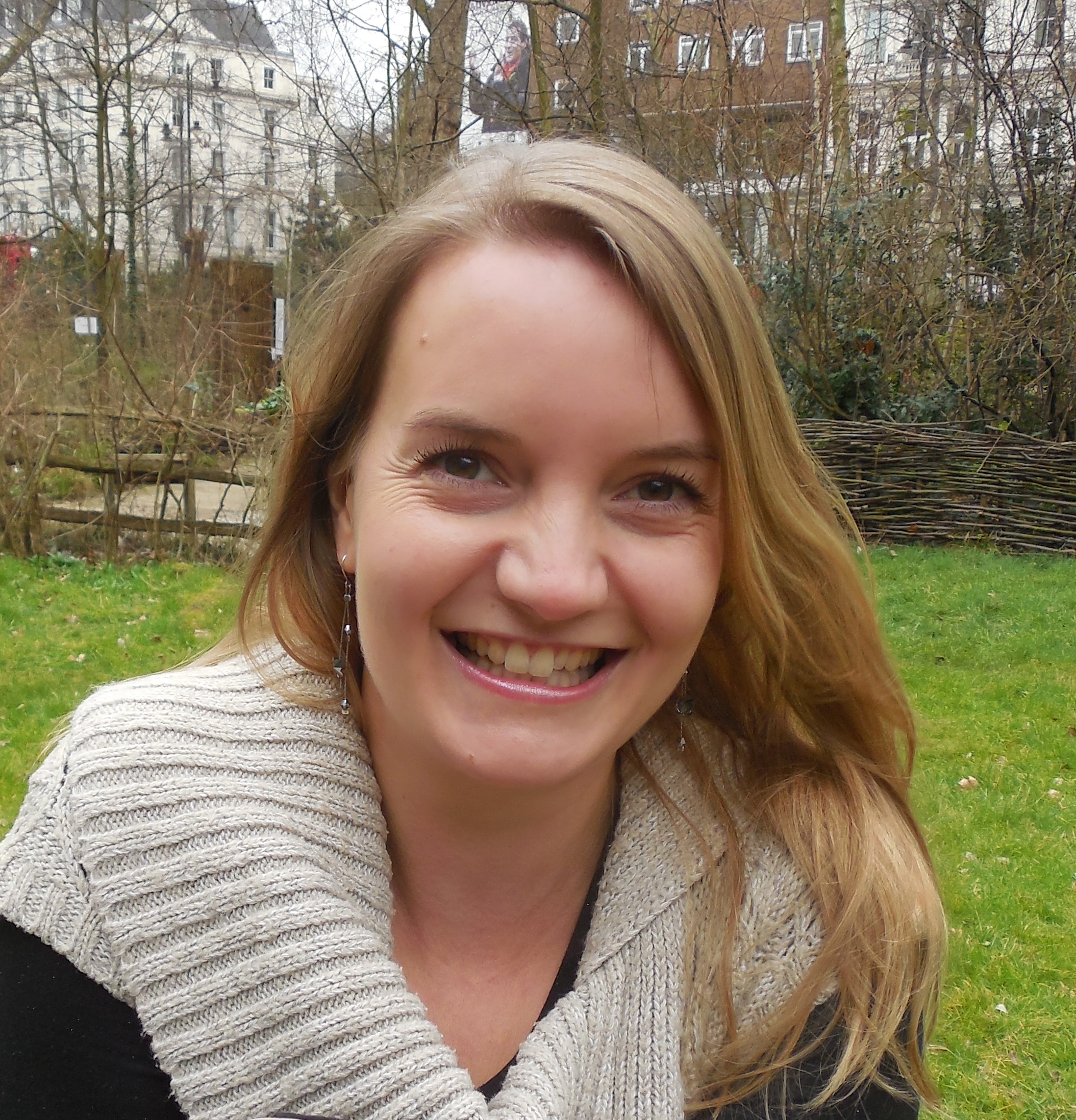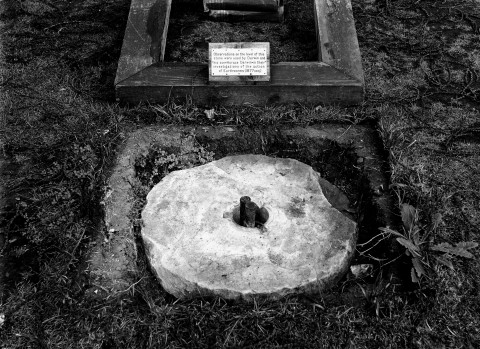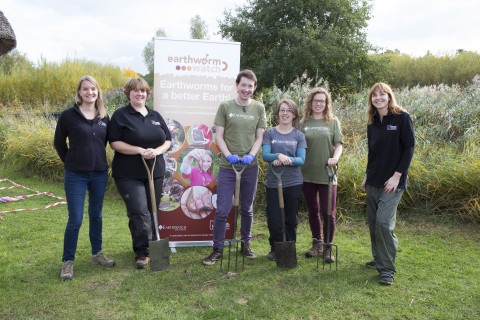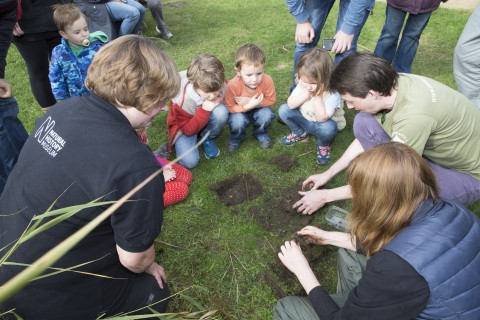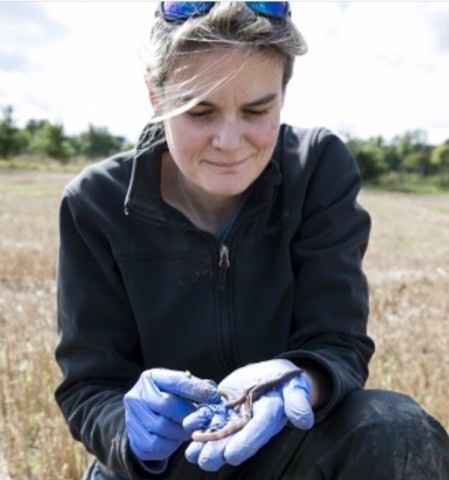Thanks to those of you who have signed up and supported Earthworm Watch so far this season. The next few weeks of Spring are an excellent time to find earthworms in your gardens, allotments and green spaces. If you have received your survey pack, but have yet to dig for earthworms and submit your records, please get involved. Earthworm Watch is particularly interested in the help of anyone passionate about their gardens and green spaces. You can hear Victoria Burton, PhD researcher at The Natural History Museum who was recently heard on BBC Radio 4’s Gardener’s Question Time talking about the variety of earthworm types found in gardens and their importance for healthy, productive soils.
Victoria works with Lucy Robinson at The Natural History Museum in the Angela Marmont Centre for UK Biodiversity. I interviewed Lucy, the museum’s Citizen Science Manager, and asked her a few questions about her role as part of the Earthworm Watch team. In Lucy’s words, she explains how she got involved and what inspires her about earthworms along with the museum’s world class research.
What is your role on the Earthworm Watch team?
Hi, I’m Lucy. I work at the Natural History Museum in London, managing a range of different citizen science projects, one of which is Earthworm Watch. When we say ‘citizen science’ we mean science research projects where we collaborate with members of the public to carry out world class research. In the case of Earthworm Watch, we need observations from all over the UK, and so the best way is to work with members of the public to gather those observations. My role is to support scientists to set up projects like these, including designing the instruction booklets, promoting the projects and reporting the results back to the people who take part.
How did you become interested in studying earthworms?
Nine years ago I started working at the Museum on citizen science, as part of a big partnership called OPAL (www.OPALexplorenature.org) which also runs an earthworm survey. I was involved in developing that survey and delivering lots of public training events to get people involved. Through that I learned a lot about worms, and was involved in establishing the Earthworm Society of Britain.
What got you into a career in science in the first place and how did this lead to your current role?
Visiting the zoo as a child really inspired me to work in wildlife conservation (I have a particular love of chimpanzees), so I studied science subjects at school and Zoology at university. During that time I realised there were many different jobs in science available to me and I really enjoyed working with members of the public, meeting lots of different people and sharing my love of nature with them. Via a couple of years working at a Museum in Exeter and a masters course back at university, this led me to the Natural History Museum – an amazing place to work!
What interests you about earthworms and the project Earthworm Watch?
I’m intrigued by how common earthworms are yet how little we all know about them. Pretty much everyone knows what an earthworm is, but almost no-one can name more than one species of earthworm (or even know that there is more than one type!). They are also out of sight and out of mind – I don’t think many of us appreciate just how many of them there are down there (millions!), and how they are busily transforming the soil in our gardens, parks, woodlands and meadows. Earthworm Watch is all about discovery and exploration of something very common, but under-studied.
Why do you think the science of Earthworm Watch is important?
Earthworm Watch is about much more than digging some holes and counting worms. The data gathered are feeding into international research partnerships that are transforming our understanding of how habitats on Earth may respond to future climate change. That said, the survey is designed such that absolutely anyone can take part and send in meaningful, useful data. I think it’s very exciting that anyone in the UK can contribute to such important research.
What is it about science that interests or excites you?
I’m very lucky to work with some of the top researchers in this country. Their work is helping to tackle deadly diseases in developing countries, helping to understand how to protect crops from pests so that people don’t go hungry, understanding the microscopic life in the Antarctic and managing the naming of species of animals, plants and fungi that is the foundation of all study of life on Earth. To me it’s very exciting to see first-hand how science is making the world a better place.
How does what you do impact on our knowledge and the public’s understanding of science?
I’m less interested in ‘public understanding of science’ and more keen to promote ‘public involvement in science’. Science and technology influences all of our lives in sometimes unexpected ways. It affects which animals and plants we find in our gardens, how good our washing machines are at removing stains from our clothes, how many stars we can see in the sky on a clear night, and whether or not we suffer from a particular medical condition and how it may be treated. Whatever part of science you feel most interested in or affected by, I hope you feel inspired to discover more about it and getting actively involved. That’s what citizen science is all about.
How do you think science and scientists are regarded by the public?
‘The public’ are a very mixed bunch! We are all individuals and our experiences in life affect how we perceive science and scientists, or whether we think about them at all. Scientists are people too and they’re also a mixed bunch! People often use stereotypes of Einstein-like characters in lab coats to represent scientists, but I hope that citizen science projects and many of the other programmes run by organisations like the Museum are starting to show that a wide range of people work in science jobs, and that there are an awful lot of jobs in science that don’t involve labs!
What has been the highlight of your career so far?
Hmm, good question. I’ve done loads of fun things – being filmed at the Wembury BioBlitz event for a TV documentary about the Museum was really fun, and I’ve loved collaborating with colleagues in the USA who work on citizen science projects - I’ve been lucky enough to travel to visit them a few times. I also see the little things as highlights too. I love when a young child holds a bug for the first time and the excited look on their face. Those moments are what really make the job worthwhile.
If you could choose another career in science, what would it be and why?
As a child I loved watching the TV programme ‘999’, so maybe I’d be a paramedic. I’m a bit squeamish though, so that’s probably why that career path never took off for me(!), but I like the idea of helping people when they are most in need.
Earthworm Watch has been developed by Earthwatch (Europe), The Natural History Museum and the Earthworm Society of Britain to better understand the ecosystem benefits of earthworms. Earthworms recycle decaying organic material to improve soil fertility, they aerate the soil to create space for air and water through their burrowing actions which can prevent flooding and store carbon in fragments in the soil. Earthworm Watch allows the public to help scientists map their abundance, better understand the human impact on their populations and with further research measure the services these ‘ecosystem engineers’ provide.

